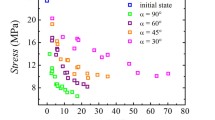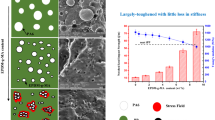Abstract
In this article, the relationship between fracture surface feature and impact properties of poly(butylene terephthalate) (PBT) was investigated. The results indicated that the fracture surface morphology of notched impact specimens tested in the temperature range from 196 to 180 °C could be differentiated into brittle (T ≤ 20 °C) and ductile appearances (T > 20 °C). The fracture surface roughness was characterized by surface roughness ratio (R s) and fractal dimension (D b). The fracture mode significantly influenced the relationship between impact strength and fracture surface roughness. When PBT fractured in a brittle mode, both the measured values of R s and D b could correspond to impact strength appropriately. On the contrary, when PBT fractured in a ductile mode, their relationship became not statistically significant because the area of the plastic deformation zone instead of fracture surface roughness might be the major factor influencing impact strength.










Similar content being viewed by others
References
Volkel M (2005) Brittle fracture in PBT. Kunstst-Plast Eur 95:191–194
Takahashi Y, Murakami K, Nishikawa S (2002) Mechanism for the phase transition of poly(butylenes terephthalate). J Polym Sci Polym Phys 40:765–771
Weichenhain R, Wesner DA, Pfleging W, Horn H, Kreutz EW (1997) KrF-excimer laser pretreatment and metallization of polymers. Appl Surf Sci 110:264–269
Gerson LM, Leonardo BC, Elias HJ, Luiz AP (2001) Toughening of PBT by ABS, SBS and HIPS systems and the effects of reactive functionalized copolymers. Macromol Symp 176:167–180
Sun SL, Tan ZY, Zhou C, Zhang MY, Zhang HX (2007) Effect of ABS grafting degree and compatibilization on the properties of PBT/ABS blends. Polym Compos 28:484–492
Xiao JF, Hu YA, Lu HD, Cai YB, Chen ZY (2007) Effect of order of mixing on morphology and thermal properties of the compatibilized PBT and ABS alloys/OMMT nanocomposites. J Appl Polym Sci 104:2130–2139
Canto LB, Hage E, Pessan LA (2006) Effects of the molecular structure of impact modifier and compatibilizer on the toughening of PBT/SBS/PS-GMA blends. J Appl Polym Sci 102:5795–5807
Larocca NM, Hage E, Pessan LA (2005) Effect of reactive compatibilization on the properties of poly(butylene terephthalate)/acrylonitrile-ethylene-propylene-diene-styrene blends. J Polym Sci Polym Phys 43:1244–1259
Kelnar I, Kotek J, Munteanu BS, Kaprálková L (2004) PBT blends with rigid polymer and elastomer inclusions: the effect of component type and reactivity on mechanical behaviour. Polym Int 53:2066–2071
Larocca NM, Hage E, Pessan LA (2004) Toughening of poly(butylene terephthalate) by AES terpolymer. Polymer 45:5265–5277
Yuan Q, Misra RDK (2006) Impact fracture behavior of clay-reinforced polypropylene nanocomposites. Polymer 47:4421–4433
Doyle MJ (1982) Nucleation and propagation of cracks in a polystyrene craze layer. J Mater Sci 17:760–768
Luo WB, Yang TQ, Wang XY (2004) Time-dependent craze zone growth at a crack tip in polymer solids. Polymer 45:3519–3525
Cheng C, Hiltner A, Baer E, Soskey PR, Mylonakis SG (1994) Deformation of rubber-toughened polycarbonate: macroscale analysis of the damage zone. J Appl Polym Sci 52:177–193
Liu K, Piggott MR (1998) Fracture failure processes in polymers. I: mechanical tests and results. Polym Eng Sci 38:60–68
Mathew AP, Thomas S (2001) Izod impact behavior of natural rubber/polystyrene interpenetrating polymer networks. Mater Lett 50:154–163
Wu HY, Ma G, Xia YM (2004) Experimental study of tensile properties of PMMA at intermediate strain rate. Mater Lett 58:3681–3685
Lee EKC, Rudin A, Plumtree AJ (1995) The interpretation and use of fracture surface morphology—a special case for polystyrene. J Mater Sci 30:2091–2096
Kulawansa DM, Langford SC, Dickinson JT (1992) Scanning tunneling microscope observations of polymer fracture surfaces. J Mater Res 7:1292–1302
Zhang MJ, Zhi FX, Su XR (1989) Fracture toughness and crack growth mechanism for multiphase polymers. Polym Eng Sci 29:1142–1146
Luo WB, Yang TQ (2003) Computer simulation of conic-shaped patterns on fracture surfaces of polymers. J Appl Polym Sci 89:1722–1725
Kinloch AJ, Young RJ (1983) Fracture behaviour of polymers. Applied Science Publishers, London
Brandt A, Prokopski G (1993) On the fractal dimension of fracture surfaces of concrete elements. J Mater Sci 28:4762–4766
Issa MA, Hammad AM (1994) Assessment and evaluation of fractal dimension of concrete fracture surface digitized images. Cem Concr Res 24:325–334
Carpinteri A, Chiaia B (1995) Multifractal nature of concrete fracture surfaces and size effects on nominal fracture energy. Mater Struct 28:435–443
Gokhale AM, Underwood EE (1990) A general method for estimation of fracture roughness. Metall Trans A Phys Metall Mater Sci 21:1193–1199
Hammad AM, Issa MA (1994) Fractal dimension as a measure of roughness of concrete fracture trajectories. Adv Cem Based Mater 1:169–177
Yu J, Jin ZH, Lei H, Liu YC, Luo Z (1999) The quantitative relation between notched impact strength and fracture surface roughness of polymer materials. Acta Polym Sin 5:612–615
ElSaundani SM (1978) Profilometric analysis of fractures. Metallography 11:247–336
Chermant JL, Coster M (1979) Review quantitative fractography. J Mater Sci 14:509–534
Wright K, Karlsson B (1983) Topographic quantification of non-planar localized surfaces. J Microsc-Oxford 1:37–51
Underwood EE (1986) Estimating fracture characteristics by quantitative fractography. J Met 38:106–178
Gokhale AM, Underwood EE (1986) A new parametric roughness equation for quantitative fractography. Acta Stereol 8:43–52
Lech C, Andrzdj G, Joanna K (2001) On the characterization of polymer concrete fracture surface. Cem Concr Comp 23:399–403
Huang ZH, Tian JF, Wang ZG (1990) Study of irregular surfaces by secondary electron line scanning. Mater Sci Eng A Struct 129:1–4
Huang ZH, Tian JF, Wang ZG (1989) Analysis of fractal characteristics of fractured surfaces by secondary electron line scanning. Mater Sci Eng A Struct 118:19–24
Wang X, Zhou H, Wang ZH, Tian MS, Liu YS, Kong QP (1999) Fractal analysis of cyclic creep fractured surfaces of two high temperature alloys. Mater Sci Eng A Struct 266:250–254
Li XW, Tian JF, Kang Y, Su HH, Wang ZG (1996) Quantitative characterization of fracture surface roughness using secondary electron line scanning method. J Mater Sci Lett 15:2137–2140
Yu J, Xu T, Tian YZ, Chen XJ, Luo Z (2002) The effects of the aggregation structure parameters on impact-fractured surface fractal dimension and strain-energy release rate for polypropylene. Mater Des 23:89–95
Andreas S, Manfred K, Robert HS (2007) Characterization of surface activity of carbon black and its relation to polymer-filler interaction. Macromol Mater Eng 292:885–916
Acknowledgments
The authors gratefully acknowledge financial support for this work from Guizhou Flare Plan (No. 20008005) and Guizhou Science Fund (No. 20003072).
Author information
Authors and Affiliations
Corresponding authors
Rights and permissions
About this article
Cite this article
Du, P., Xue, B., Song, Y. et al. Fracture surface characteristics and impact properties of poly(butylene terephthalate). Polym. Bull. 64, 185–196 (2010). https://doi.org/10.1007/s00289-009-0199-8
Received:
Revised:
Accepted:
Published:
Issue Date:
DOI: https://doi.org/10.1007/s00289-009-0199-8




